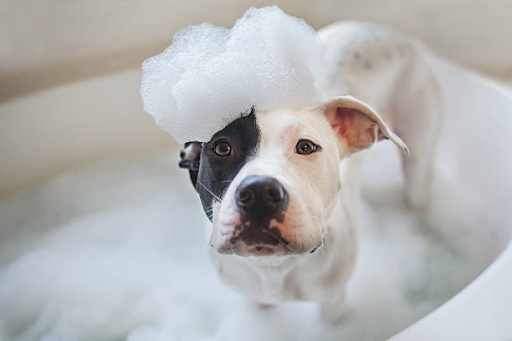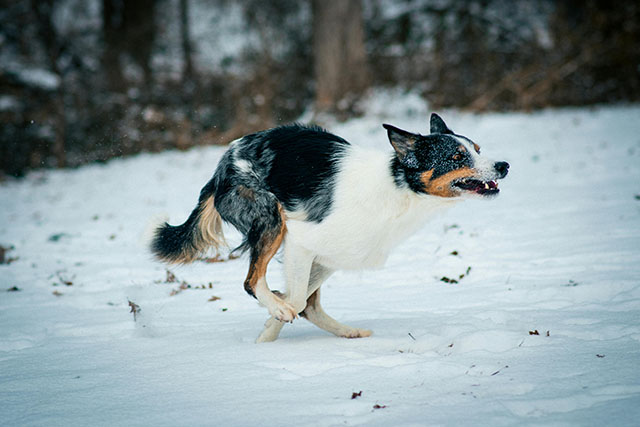You may think you know everything there is to know about canine hygiene, but do you really know the facts behind washing your pup? Some popular beliefs around bathing frequency lead pet owners down a path of misinformation and incorrect cleaning routines.
Pups need fresh water and clean fur for their well-being, just like humans! To help clear up any confusion, we’ve compiled an in-depth analysis of common misconceptions regarding how often it’s necessary (or even recommended) to bathe your four-legged friend.
Keep reading to learn more and ensure your dog gets all the TLC they deserve!
How Often You Should Actually Bathe Your Dog According to a Veterinarian?
The frequency of bathing your dog depends on various factors, such as their breed, activity level, and coat type. Contrary to what some may think, most dogs do not need frequent baths, and over-bathing can actually be harmful. Here’s what veterinarians recommend:
Breed Matters
Different dog breeds have different coat types. Long-haired breeds like the Shih Tzu or Afghan Hound may need more frequent baths to prevent matting, while short-haired breeds like the Beagle or Boxer may require less frequent baths.
Activity Level
If your dog loves rolling in mud puddles or frequently plays outdoors, they may need more baths than a couch-potato pup.
Skin Conditions
Dogs with skin conditions, such as allergies or dermatitis, may require special shampoos and bathing schedules as their veterinarian recommends.
Age
Puppies have delicate skin and should be bathed sparingly, while senior dogs may need more frequent baths due to incontinence or mobility issues.
Regular Brushing
Regular brushing can reduce the need for baths by removing dirt, debris, and loose fur from your dog’s coat.
In most cases, veterinarians recommend bathing your dog every 2 to 3 months or as needed. Frequent baths can strip your dog’s coat of natural oils, leading to dry skin and irritation.
Is It OK to Bathe a Dog Every Day?
Bathing your dog every day is generally not recommended, and here’s why:
- Stripping Natural Oils: Daily baths can strip your dog’s skin and coat of essential oils, leading to dryness, itching, and potential skin problems.
- Disrupting the Skin’s pH: Frequent bathing can disrupt your dog’s skin pH balance, making it more susceptible to infections.
- Allergies and Irritations: Bathing too often can increase your dog’s risk of allergies and skin irritations.
However, there are exceptions. Some dogs with specific medical conditions may require daily baths prescribed by a veterinarian. Always follow your vet’s advice regarding any special bathing schedule for your dog.
What Not to Do When Bathing a Dog
- Using Human Shampoo: Using human shampoo on your dog is one of the most common missteps to avoid. Such shampoos can be overly harsh and disrupt your furry friend’s delicate skin pH balance. Instead, it’s always advisable to opt for a dog-specific shampoo that comes highly recommended by your veterinarian. Take, for example, the Pride and Groom Collection of Dog Shampoo & Conditioner—a superb choice that caters to shedders, non-shedders, and sensitive skin. This exceptional product is enriched with essential oils and coat-specific ingredients, providing optimal moisture, soothing properties, nourishment, and a brilliant shine. With a generous 16 fl oz size, it is a must-have for your dog’s bathing routine.
- Neglecting Brushing: Neglecting to brush your dog before bathing can result in mats and tangles in their coat. Brushing helps eliminate loose fur and facilitates a smoother bathing process. Consider trying the FlexIt Grooming Brush – a fantastic tool for double-coated dogs. With its dual functionality, time-saving features, and high-quality material, this brush is a must-have for any dog owner. Its ergonomic design ensures comfort, while the easy-to-clean and versatile nature makes it an effective option. Don’t forget to add this oblong-shaped brush to your grooming routine.
- Cold Water or Hot Water: Extreme water temperatures can be uncomfortable for your dog. Use lukewarm water to ensure they are comfortable throughout the bath.
- Neglecting Safety Measures: Place a non-slip mat in the bathtub to prevent your dog from slipping. Always keep one hand on your dog during the bath to provide support and reassurance.
- Getting Water in Their Ears: Water getting into your dog’s ears can lead to infections. Be cautious and avoid getting water inside their ears. You can place a cotton ball in each ear to help keep them dry.
- Stressful Environment: Bathing can be stressful for some dogs. Create a calm and soothing environment, use a gentle tone, and reward your dog with treats and positive reinforcement to make the experience more pleasant.
- Rushing the Process: Take your time when bathing your dog. Rushing can lead to accidents, and your dog may become anxious. Slow, gentle movements will help both of you feel more at ease.
- Using High-Pressure Water: Avoid using high-pressure water hoses or showerheads. The force of the water can be frightening for dogs. Instead, use a handheld sprayer with adjustable pressure or a pitcher to pour water over your dog.
- Skipping the Rinse: Ensure you rinse your dog thoroughly to remove all shampoo residue. Leftover shampoo can cause skin irritation.
- Forgetting to Dry Properly: Dry your dog thoroughly with a clean towel or a low-heat setting on a pet-safe hairdryer after the bath. Leaving your dog damp can lead to skin issues or chilling.
- Trimming Nails During a Bath: Bath time is not the right time to trim your dog’s nails. Leave nail trimming for a separate session to avoid accidents or causing your dog discomfort.
- Over-Restraining: While keeping your dog secure during the bath is essential, over-restraining can lead to fear and anxiety. Use a gentle, non-restrictive method to keep your dog in place, such as a leash attached to a secure point.
How Do I Keep My Dog Smelling Good?
Maintaining your dog’s pleasant scent between baths is essential. Here are some tips to keep your furry friend smelling fresh:
- Regular Brushing: Regularly brush your dog’s coat to remove dirt, debris, and loose fur. This not only keeps them clean but also reduces shedding and odors.
- Dental Hygiene: Bad breath can contribute to a less-than-pleasant smell. Brush your dog’s teeth regularly or provide dental chews and toys to promote oral health. Consider DentaLife, a large dog dental chew for active, fresh daily oral care. This promotes optimal oral health for your furry companion.
- Quality Diet: Feeding your dog a high-quality diet can affect their body odor. Consult with your veterinarian to ensure your dog is getting the right nutrients.
- Regular Grooming: Depending on your dog’s breed, regular grooming appointments can help maintain their coat and overall cleanliness.
- Wipe Down: After walks or outdoor play, wipe your dog’s paws and belly to remove dirt and prevent odors from setting in.
- Use Dog-Friendly Deodorizers: Dog-friendly sprays and deodorizers are available to help keep your dog smelling fresh between baths.
Can I Bathe My Dog Every Day If He Has Fleas?
Fleas are a common nuisance for dogs, and it’s natural to want to get rid of them quickly. However, daily bathing is not the most effective approach. Here’s what you should do instead:
Consult Your Vet
If your dog has fleas, consult your veterinarian for appropriate flea control and treatment options. They may recommend topical treatments, oral medications, or flea collars.
Use Flea Shampoo Sparingly
While flea shampoos can help in the short term, using them daily can be harsh on your dog’s skin and coat. Follow your vet’s instructions for safe and effective use.
Environmental Control
To combat fleas effectively, you must also treat your home and yard. Vacuum regularly, wash your dog’s bedding, and use flea treatments in your environment as recommended.
Preventive Measures
Invest in a monthly flea preventive prescribed by your veterinarian to keep fleas at bay. Prevention is often easier and more effective than treating a full-blown infestation.
How Do I Know When My Dog Needs a Bath?
Dogs have their way of communicating when they need a bath. Here are some signs that indicate it’s time for a bath:
- Unpleasant Odor: If your dog smells less than fresh, it clearly indicates they could use a bath.
- Visible Dirt and Stains: If your dog’s coat is visibly dirty, stained, or matted, it’s time for a bath.
- Scratching and Itching: Excessive scratching or itching can be a sign of skin irritation or allergies, which may require a bath with a medicated shampoo, as your vet recommends.
- Rolling in Unpleasant Substances: Dogs have a knack for finding stinky things to roll in. If your dog has had a run-in with something foul, a bath is in order.
- Incontinence or Illness: Senior dogs or those with certain medical conditions may need more frequent baths due to incontinence or skin issues related to their illness. It’s time to dispel those myths! To delve deeper into this topic, be sure to watch this informative video:
Final Words
Bathing your dog is essential to their care routine, but it’s important to do it at the right frequency and with the proper products. Remember that less is often more when it comes to dog baths. Consult your veterinarian for guidance specific to your dog’s needs, and always prioritize their comfort and well-being. You can keep your furry friend clean, happy, and smelling great with the right care and attention.
Jessica is a veterinary medicine student who is passionate about animals. Living with her cherished dog, Milo, deepens her understanding of the human-animal connection, enhancing her empathy as a future veterinarian.
Jessica’s concise articles reflect her dedication to improving the lives of animals and those who care for them, making her an inspiring figure in the pet care field.






